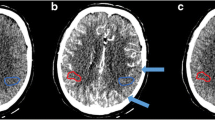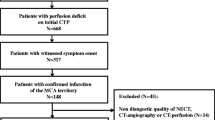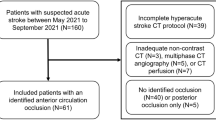Abstract
In order to identify patients who suffer from hemodynamic cerebral insufficiency and can benefit from cerebral revascularization procedures, xenon-CT scanning has been established to reliably measure the critical cerebrovascular reserve capacity. As a need for alternative quantification methods arises, this study aims to characterize the significance of both time-to-peak (TTP) and mean transit time (MTT) in perfusion-weighted imaging (PWI) in this particular subset of patients. Ten patients in routine preoperative work-up for cerebral revascularization were prospectively enrolled and underwent both XeCT scanning and PWI. Cerebrovascular reserve capacity (CVRC) was calculated for each region of interest (ROI, n = 504) after administration of a vasoactive stimulus. ROIs were anatomically matched with those of PWI after TTP and MTT were calculated. Highly significant negative correlation was found for TTP and CVRC for all ROIs (r = −0.3954, p < 0.0001; symptomatic ROIs: r = −0.4867, p < 0.0001). Correlation was weak for MTT and CVCR (r = −0.1287; p < 0.01). The optimum threshold for TTP to detect impaired cerebrovascular reactivity in our patient group was 4 s (specificity 90.8%, sensitivity 44.4%) for all ROIs (TTP > 4.4 s for symptomatic ROIs, specificity 88.4%, sensitivity 62.7%). An approximative equation to calculate the probability of pathological findings could be derived from the data. The positive predictive value (PPV) was 0.76 (symptomatic 0.78) with a negative predictive value (NPV) of 0.71 (symptomatic 0.78). While PWI currently is not able to replace XeCT in the direct quantification of CVRC, it may serve as a readily available follow-up tool. A TTP threshold of greater than 4 s allows to confirm a cerebrovascular compromise in a selected high-risk subgroup of patients.



Similar content being viewed by others
References
Butcher KS, Parsons M, MacGregor L, Barber PA, Chalk J, Bladin C, Levi C, Kimber T, Schultz D, Fink J, Tress B, Donnan G, Davis S (2005) Refining the perfusion–diffusion mismatch hypothesis. Stroke 36(6):1153–1159
Derdeyn CP, Grubb RL Jr., Powers WJ (2005) Indications for cerebral revascularization for patients with atherosclerotic carotid occlusion. Skull Base 15(1):7–14
Drayer BP, Wolfson SK, Reinmuth OM, Dujovny M, Boehnke M, Cook EE (1978) Xenon enhanced CT for analysis of cerebral integrity, perfusion, and blood flow. Stroke 9(2):123–130
Ducreux D, Buvat I, Meder JF, Mikulis D, Crawley A, Fredy D, TerBrugge K, Lasjaunias P, Bittoun J (2006) Perfusion-weighted MR imaging studies in brain hypervascular diseases: comparison of arterial input function extractions for perfusion measurement. AJNR Am J Neuroradiol 27(5):1059–1069
EC/IC BSG (1985) Failure of extracranial–intracranial arterial bypass to reduce the risk of ischemic stroke. Results of an international randomized trial. N Engl J Med 313(19):1191–1200
Fisher M, Albers GW (1999) Applications of diffusion–perfusion magnetic resonance imaging in acute ischemic stroke. Neurology 52(9):1750–1756
Furukawa M, Kashiwagi S, Matsunaga N, Suzuki M, Kishimoto K, Shirao S (2002) Evaluation of cerebral perfusion parameters measured by perfusion CT in chronic cerebral ischemia: comparison with xenon CT. J Comput Assist Tomogr 26(2):272–278
Grubb RL Jr., Powers WJ, Derdeyn CP, Adams HP Jr., Clarke WR (2003) The Carotid Occlusion Surgery Study. Neurosurg Focus 14(3):9
Gur D, Good WF, Wolfson SK Jr., Yonas H, Shabason L (1982) In vivo mapping of local cerebral blood flow by xenon-enhanced computed tomography. Science 215(4537):1267–1268
Gur D, Yonas H, Herbert D, Wolfson SK, Kennedy WH, Drayer BP, Gray J (1981) Xenon enhanced dynamic computed tomography: multilevel cerebral blood flow studies. J Comput Assist Tomogr 5(3):334–340
Hagen T, Bartylla K, Piepgras U (1999) Correlation of regional cerebral blood flow measured by stable xenon CT and perfusion MRI. J Comput Assist Tomogr 23(2):257–264
Heiland S, Sartor K (1999) [Magnetic resonance tomography in stroke—its methodological bases and clinical use]. Rofo Fortschr Geb Rontgenstr Neuen Bildgeb Verfahr 171(1):3–14
Horn P, Vajkoczy P, Thome C, Muench E, Schilling L, Schmiedek P (2001) Xenon-induced flow activation in patients with cerebral insult who undergo xenon-enhanced CT blood flow studies. AJNR Am J Neuroradiol 22(8):1543–1549
Johnson DW, Stringer WA, Marks MP, Yonas H, Good WF, Gur D (1991) Stable xenon CT cerebral blood flow imaging: rationale for and role in clinical decision making. AJNR Am J Neuroradiol 12(2):201–213
Kikuchi K, Murase K, Miki H, Kikuchi T, Sugawara Y, Mochizuki T, Ikezoe J, Ohue S (2001) Measurement of cerebral hemodynamics with perfusion-weighted MR imaging: comparison with pre- and post-acetazolamide 133Xe-SPECT in occlusive carotid disease. AJNR Am J Neuroradiol 22(2):248–254
Kikuchi K, Murase K, Miki H, Yasuhara Y, Sugawara Y, Mochizuki T, Ikezoe J, Ohue S (2002) Quantitative evaluation of mean transit times obtained with dynamic susceptibility contrast-enhanced MR imaging and with (133)Xe SPECT in occlusive cerebrovascular disease. AJR Am J Roentgenol 179(1):229–235
Kim JH, Lee SJ, Shin T, Kang KH, Choi PY, Gong JC, Choi NC, Lim BH (2000) Correlative assessment of hemodynamic parameters obtained with T2*-weighted perfusion MR imaging and SPECT in symptomatic carotid artery occlusion. AJNR Am J Neuroradiol 21(8):1450–1456
Kuroda S, Kamiyama H, Abe H, Houkin K, Isobe M, Mitsumori K (1993) Acetazolamide test in detecting reduced cerebral perfusion reserve and predicting long-term prognosis in patients with internal carotid artery occlusion. Neurosurgery 32(6):912–8 discussion 918–919
Langer DJ, Vajkoczy P (2005) ELANA: excimer laser-assisted nonocclusive anastomosis for extracranial-to-intracranial and intracranial-to-intracranial bypass: a review. Skull Base 15(3):191–205
Latchaw RE, Yonas H, Pentheny SL, Gur D (1987) Adverse reactions to xenon-enhanced CT cerebral blood flow determination. Radiology 163(1):251–254
Lythgoe DJ, Ostergaard L, William SC, Cluckie A, Buxton-Thomas M, Simmons A, Markus HS (2000) Quantitative perfusion imaging in carotid artery stenosis using dynamic susceptibility contrast-enhanced magnetic resonance imaging. Magn Reson Imaging 18(1):1–11
Nasel C, Azizi A, Wilfort A, Mallek R, Schindler E (2001) Measurement of time-to-peak parameter by use of a new standardization method in patients with stenotic or occlusive disease of the carotid artery. AJNR Am J Neuroradiol 22(6):1056–1061
Nussbaum ES, Erickson DL (2000) Extracranial–intracranial bypass for ischemic cerebrovascular disease refractory to maximal medical therapy. Neurosurgery 46(1):37–42 discussion 42–3
Ostergaard L (2005) Principles of cerebral perfusion imaging by bolus tracking. J Magn Reson Imaging 22(6):710–717
Pindzola RR, Balzer JR, Nemoto EM, Goldstein S, Yonas H (2001) Cerebrovascular reserve in patients with carotid occlusive disease assessed by stable xenon-enhanced ct cerebral blood flow and transcranial Doppler. Stroke 32(8):1811–1817
Rempp KA, Brix G, Wenz F, Becker CR, Guckel F, Lorenz WJ (1994) Quantification of regional cerebral blood flow and volume with dynamic susceptibility contrast-enhanced MR imaging. Radiology 193(3):637–641
Sase S, Honda M, Machida K, Seiki Y (2005) Comparison of cerebral blood flow between perfusion computed tomography and xenon-enhanced computed tomography for normal subjects: territorial analysis. J Comput Assist Tomogr 29(2):270–277
Schmiedek P (1989) EC–IC bypass in hemodynamic cerebrovascular disease. J Neurosurg 71(3):464–466
Schmiedek P, Piepgras A, Leinsinger G, Kirsch CM, Einhäupl K (1994) Improvement of cerebrovascular reserve capacity by EC–IC arterial bypass surgery in patients with ICA occlusion and hemodynamic cerebral ischemia. J Neurosurg 81(2):236–244
Shiino A, Morita Y, Tsuji A, Maeda K, Ito R, Furukawa A, Matsuda M, Inubushi T (2003) Estimation of cerebral perfusion reserve by blood oxygenation level-dependent imaging: comparison with single-photon emission computed tomography. J Cereb Blood Flow Metab 23(1):121–135
Sobesky J, Zaro Weber O, Lehnhardt FG, Hesselmann V, Thiel A, Dohmen C, Jacobs A, Neveling M, Heiss WD (2004) Which time-to-peak threshold best identifies penumbral flow? A comparison of perfusion-weighted magnetic resonance imaging and positron emission tomography in acute ischemic stroke. Stroke 35(12):2843–2847
Stringer WA (1991) Accuracy of xenon CT measurement of cerebral blood flow. AJNR Am J Neuroradiol 12(1):86–87
Togao O, Mihara F, Yoshiura T, Tanaka A, Noguchi T, Kuwabara Y, Kaneko K, Matsushima T, Honda H (2006) Cerebral hemodynamics in Moyamoya disease: correlation between perfusion-weighted MR imaging and cerebral angiography. AJNR Am J Neuroradiol 27(2):391–397
Webster MW, Makaroun MS, Steed DL, Smith HA, Johnson DW, Yonas H, Latchaw RE, Wolfson SK Jr., Gur D (1995) Compromised cerebral blood flow reactivity is a predictor of stroke in patients with symptomatic carotid artery occlusive disease. J Vasc Surg 21(2):338–344 discussion 344–5
Webster MW, Steed DL, Yonas H, Latchaw RE, Wolfson SK Jr., Gur D (1986) Cerebral blood flow measured by xenon-enhanced computed tomography as a guide to management of patients with cerebrovascular disease. J Vasc Surg 3(2):298–304
Wintermark M, Sesay M, Barbier E, Borbely K, Dillon WP, Eastwood JD, Glenn TC, Grandin CB, Pedraza S, Soustiel JF, Nariai T, Zaharchuk G, Caille JM, Dousset V, Yonas H (2005) Comparative overview of brain perfusion imaging techniques. Stroke 36(9):e83–99
Wintermark M, Thiran JP, Maeder P, Schnyder P, Meuli R (2001) Simultaneous measurement of regional cerebral blood flow by perfusion CT and stable xenon CT: a validation study. AJNR Am J Neuroradiol 22(5):905–914
Yamashita T, Kashiwagi S, Nakano S, Takasago T, Abiko S, Shiroyama Y, Hayashi M, Ito H (1991) The effect of EC–IC bypass surgery on resting cerebral blood flow and cerebrovascular reserve capacity studied with stable XE-CT and acetazolamide test. Neuroradiology 33(3):217–22
Yonas H, Darby JM, Marks EC, Durham SR, Maxwell C (1991) CBF measured by Xe-CT: approach to analysis and normal values. J Cereb Blood Flow Metab 11(5):716–725
Yonas H, Gur D, Good BC, Latchaw RE, Wolfson SK Jr., Good WF, Maitz GS, Colsher JG, Barnes JE, Colliander KG et al (1985) Stable xenon CT blood flow mapping for evaluation of patients with extracranial–intracranial bypass surgery. J Neurosurg 62(3):324–333
Yonas H, Pindzola RP, Johnson DW (1996) Xenon/computed tomography cerebral blood flow and its use in clinical management. Neurosurg Clin N Am 7(4):605–616
Yonas H, Smith HA, Durham SR, Pentheny SL, Johnson DW (1993) Increased stroke risk predicted by compromised cerebral blood flow reactivity. J Neurosurg 79(4):483–489
Acknowledgments
We would like to particularly thank the technicians of the Department of Neuroradiology for their support.
Disclosure
Preliminary results were presented at the “8th International Conference on Xenon CT and Related CBF Techniques” in Cambridge, UK in 2006 and the 58th meeting of the German Society of Neurosurgery, Leipzig, Germany in 2007.
Author information
Authors and Affiliations
Corresponding author
Additional information
Comments
Maximilian Mehdorn, Kiel, Germany
Cerebral revascularization—both carotid endarterectomy (TEA) and extracranial–intracranial arterial anastomosis (ECIC)—has suffered major drawbacks since its initial highly popularized results. While TEA, due to the high incidence of arteriosclerotic stenoses in the extracranial circulation, has undergone a series of scientific trials demonstrating the benefit of surgery over medical treatment alone in well-defined patient population, the EC–IC Bypass Study published in 1985 was the only major study dealing in general with this microneurosurgical procedure and has shown that the algorithms of the late 1970s and the early 1980s in selecting candidates for this procedure were not sufficient to select patients at high risk of developing a hemodynamic stroke mainly due to carotid artery occlusion.
Many efforts have been directed to improve the criteria to select patients at risk from hemodynamic stroke, e.g. (1) the transcranial Doppler study of MCA blood flow velocity changes after exposure of the patient to diamox or CO2, (2) xenon perfusion studies or, more recently, the (3) cranial CT with perfusion studies. These studies should be repeatable because cerebrovascular insufficiency may change—often improve—over time, after a stroke, thus, making the decision for or against surgery even more difficult. While the first study is easily feasible and repeatable, it has certain problems, particularly, the need of a dedicated transcranial Doppler specialist in order to rule out inter-observer variability and the problem of acetacolamide in certain patients; xenon perfusion studies are considered the gold standard for many instances although the application to patients with cerebrovascular insufficiency may cause sedation effects. Cranial CT perfusion studies using contrast enhancing agents are not repeatable several times due to the radiation exposure and, depending on the machine used, they do not cover the major part of the brain volume.
Therefore, the study presented here by G. Schubert et al. from Mannheim aims to develop an alternative evaluation of cerebral perfusion and reserve capacity by means of MR imaging in the way of perfusion-weighted imaging (PWI), by comparing this new method to the gold standard of xenon CT. This method should be reliable, repeatable, objective, and easily applicable within the framework of modern neurosurgical workup of patients with cerebrovascular insufficiency. The authors suggest, by comparing both methods in a selected group of patients, that the application of PWI can equal the application of Xenon-CT. They are to be congratulated on their thoughtful evaluation of both methods. Understandably, the method will need to be tested in a multicenter setting in order to be validated for broad clinical use, and the reviewer is confident that they will be able to share their results on this subject in the near future, basing the indication for revascularization procedures again on objective findings. Obviously patients undergoing surgery on the basis of this method should be followed closely to prove this hypothesis.
Alexander Brawanski, Regensberg, Germany
In their paper, the authors evaluate an alternative method to test for CVRC. They used TTP and MTT and compared these in specific ROIs to the results of stable XeCT in ten patients with Moyamoya disease or unilateral or bilateral occlusive disease. The authors calculated the correlation and regression and used a ROC statistics for setting of an optimal threshold. They find a good correlation for TTP and CVRC and a worse one for MTT. Furthermore, the optimum threshold in the ROC was 4 s for the TTP parameter. The authors state, cautiously, that the TTP will not replace XeCT but could be useful as a follow up parameter. In principle, the idea of the paper is reasonable, namely to find a replacement for XeCT or other methods like HMPAO Spect with Diamox, that could be easily included in clinical routine studies. The major problem, however, is the fact, that the TTP and MTT are only indirectly related to CBF and its reactivity (N. Lassen, W. Perl, Tracer Kinetic Methods in medical Physiology, New York, 1979). Therefore, the results are not totally convincing. The idea, however, is reasonable and the look for alternatives should be pursued.
Rights and permissions
About this article
Cite this article
Schubert, G.A., Weinmann, C., Seiz, M. et al. Cerebrovascular insufficiency as the criterion for revascularization procedures in selected patients: a correlation study of xenon contrast-enhanced CT and PWI. Neurosurg Rev 32, 29–36 (2009). https://doi.org/10.1007/s10143-008-0159-z
Received:
Revised:
Accepted:
Published:
Issue Date:
DOI: https://doi.org/10.1007/s10143-008-0159-z




